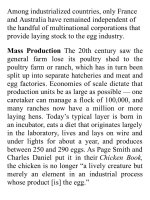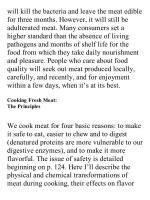On food and cooking the science and lore of the kitchen ( PDFDrive ) 1396
Bạn đang xem bản rút gọn của tài liệu. Xem và tải ngay bản đầy đủ của tài liệu tại đây (211.87 KB, 2 trang )
soaked,partlysproutedcerealgraincomes
from an Indo-European root meaning
“soft.” Words that are related to malt
includemelt,mollusc(p.226),andmollify.
LagerFromthetimesofEgyptandSumeria
totheMiddleAges,brewersmadebeer
withoutmuchcontroloverthetemperatureof
fermentation,andwithyeaststhatgrewatthe
surfaceoftheliquid.Thebeerfermentedina
fewdays,anditwasconsumedwithindaysor
weeks.Sometimearound1400,inthefoothills
oftheBavarianAlps,thereevolvedanew
kindofbeer.Itwasfermentedincoolcaves
overtheperiodofaweekormore,andwitha
specialyeastthatgrewbelowthesurfaceof
theliquid.Thenitwaspackedinicefor
severalmonthsbeforeitwasdrawnoffthe
yeastsedimentfordrinking.Thecool,slow
fermentationgavethebeeradistinctive,
relativelymildflavor,andthecold
temperatureandlongsettlingtimeproduceda
sparkling-clearappearance.Thislagerbeer
(fromtheGermanlagern,“tostore,”“tolay
down”)remaineddistinctlyBavarianuntilthe
1840s,whenthespecialyeastandtechniques
weretakentoPilsen,Czechoslovakia,to
Copenhagen,andtotheUnitedStates,and
becametheprototypeofmostmodernbeers.
EnglandandBelgiumaretheonlymajor
producersthatstillbrewmostoftheirbeerin
theoriginalway,atwarmtemperaturesand
withtop-fermentingyeasts.
England: Bottles and Bubbles, Specialty
Malts The English were late to accept hops,
but pioneered in the making of bottled beer.
Ordinaryale—theoriginalEnglishwordfor
beer — was fermented in an open tank, and
like wine it lost all its carbon dioxide to the
air:thebubblessimplyrosetothesurfaceand
burst. Some residual yeast might grow while
theliquidwasstoredinabarrel,butitwould
lose its light gassiness as soon as the barrel
was tapped. Sometime around 1600, it was









